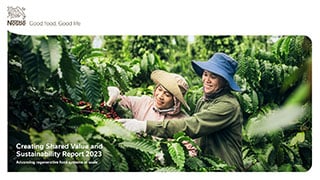Living income and living wage

Living incomes play an important role in building resilient communities and make a positive contribution to a regenerative food system.
We are using our role as a global food and beverage company to help enable and support resilient communities built on strong and sustainable livelihoods. With living income identified as one of our 10 salient human rights issues, we have worked with the non-profit Sustainable Food Lab to create an action plan which focuses on our cocoa, coffee and dairy supply chains. We will report on its implementation in 2025. We address living wages for our employees in a separate action plan.
We have developed strategies that aim to improve the livelihoods of farming families in our supply chain, by helping them close the living income gap and become more resilient and enabled to invest in regenerative agricultural practices that will be more appealing to the next generation of farmers.
We are committed to supporting improved and diversified farmer incomes through our sustainability programs. Furthermore, we aim to implement new living income programs for farmers in our value chain to make farming more attractive.
Enabling a path toward living income
Empowering farmers and their communities
Through both the Nescafé Plan and Nestlé Cocoa Plan, we invest in initiatives that help coffee and cocoa farmers to improve crop yields and implement regenerative agriculture practices that protect water resources and improve soil health and soil fertility.
Our key actions on living income
- Strengthen our risk assessment approach
- Implement dedicated living income programs in cocoa, coffee and dairy as priority raw materials for this action plan
- Align our approach to living income across priority raw materials
- Collaborate with peers and stakeholders to help address systemic issues and develop common approaches and tools for supporting a living income
- Raise awareness of and advocate for a living income within the sectors Nestlé is involved in, starting with priority raw materials
Our income accelerator program helps cocoa-farming families work toward a living income
The Nestlé income accelerator program rewards farmers not just for the quantity and quality of their cocoa beans, but also for adopting practices that benefit the environment and their community. Through a mix of cash incentives and training programs, we are enabling and incentivizing farmers and their families to close the gap to living income and simultaneously aiming at tackling child labor risks. Following a successful pilot phase, the income accelerator program has been expanded to involve 30 000 cocoa-farming families in Côte d’Ivoire. This ‘test at scale’ phase will build on initial positive results: school enrollment rates have risen, pruning has increased the productivity of cocoa farms and women have been empowered and more involved in decision-making, which has improved the allocation of family resources.
The program will be rolled out in Ghana in 2024 and aims to reach 160 0000 cocoa-growing families globally by 2030. More details can be found in our income accelerator program progress report (pdf, 2Mb).
Addressing the living income gap in coffee-growing communities
The Nescafé Plan (pdf, 9Mb) was launched in 2010 as the brand’s global sustainability initiative. In 2022, the Nescafé Plan announced a pilot financial support scheme in Mexico, Côte d’Ivoire and Indonesia to help farmers accelerate the transition to regenerative agriculture.
Activities include:
- Conditional cash incentives for adopting regenerative agriculture practices
- Income protection using weather insurance
- Tailored technical assistance including intercropping for income diversification
Dairy for You program enhances livelihoods and helps farms grow
Through the Dairy for You program, Nestlé works with over 200 000 dairy farmers in 27 countries to continuously improve local production systems that enhance farmers’ livelihoods and animal welfare. This includes farmer training in direct milk sourcing operations, which focuses on practices that optimize productivity and improve incomes.
Accompanying this program, Nestlé offers support to hundreds of thousands of smallholder dairy farmers in emerging economies to professionalize and grow into medium or large-scale farms. To do this, Nestlé uses a data-driven analysis of the current state of farms that helps to uncover the interventions needed to improve efficiency to the point where farms become economically viable. The company then supports farmers with implementation of their plan. Nestlé has rolled out this model with success in China, Pakistan, India and Colombia.

Supporting innovation and entrepreneurship
Better farming practices can improve crop yields. For example, pruning can improve the health and disease resistance of cocoa crops, resulting in a three- to four-fold increase in yield. Meanwhile, the Nescafé Plan has been distributing more climate-resistant and higher-yielding coffee plantlets to farmers. The plan provides special coaching for farmers – including female farmers – to cultivate entrepreneurship.
We are also helping farmers access capital to invest in their businesses where needed, such as through co-investment in regenerative agriculture, or Village Savings and Loans Associations. For several years we have encouraged farming families to diversify their incomes, including by growing other crops or raising livestock. This helps to mitigate their exposure to market volatility, crop disease or drought and improves cashflow between harvests of their main crop. We monitor our progress – in farming economics, social improvements and environmental benefits – in partnership with the Rainforest Alliance.

A living wage for all Nestlé employees
Since 2013, Nestlé has been implementing a Living Wage Program to ensure that all our employees, including those on temporary contracts, earn a living wage. We work with our partner Business for Social Responsibility (BSR) to help us define the living wage threshold in each country where we operate. We use this information to identify and address cases where our lowest level of compensation and legal minimum wages are not sufficient for workers to fulfill basic needs. These figures are updated on a regular basis to ensure that our employees continue to be paid at or above the living wage.
In the UK, Nestlé was the first major manufacturer back in 2014 to pledge the living wage to all its employees and in 2017 extended the commitment to cover all contractors across all its sites.
Our key actions on living wage
- Continue our Living Wage Program for Nestlé employees worldwide
- Launch living wage pilots for on-site contractors
- Engage and support prioritized direct suppliers to address living wage risks and impacts in their own operations
- Collaborate with peers and stakeholders to help address systemic issues and develop common approaches and tools on the topic of a living wage
We rely on the more than 500 000 farmers and 150 000 suppliers we source from. Transforming our food systems requires working together to improve the livelihoods of farmers and the resilience of rural communities. Rewarding farmers and suppliers for social and environmental services is part of the solution: it will have a positive impact on both people and the planet.


















